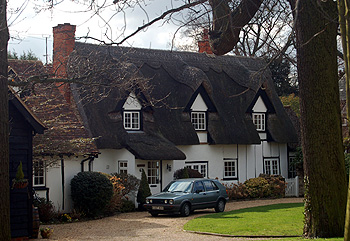63 Main Road Biddenham
![63 Main Road in 1962 [Z53/15/15]](/CommunityHistories/Biddenham/BiddenhamImages/63 Main Road in 1962 [Z53-15-15].jpg)
63 Main Road in 1962 [Z53/15/15]
63 Main Road is an attractive thatched property fronting Biddenham Green. For many years a smithy stood on The Green a few yards north-east of the frontage of the property. The Bedfordshire Historic Environment Record [HER] contains information on the county’s historic buildings and landscapes and summaries of each entry can now be found online as part of the Heritage Gateway website. The entry for the house [HER 1539] describes it as a 17th or 18th century building built from limestone rubble with colourwashed plaster over it and partly timber-framed; the roof is thatched. A modern extension stands to the east. The entry for the smithy [HER 8707] states: "The village smithy near the village green was always the centre of activity and gossip. It stood on the same site in 1794 but closed down and was demolished in 1967." Certainly the smithy is shown on a map of 1794 [X1/51]; when it was first sited there is not known.
The Rating and Valuation Act 1925 specified that every building and piece of land in the country was to be assessed to determine its rateable value. The valuer visiting the property [DV1/C123/77] found that, like many of the older cottages in the village, it was owned by the Wingfield family, Lords of the Manor of Biddenham. It was rented by William Davison, who had been the smith, for £14 per annum. The rent dated from 1900 and included the smithy.
The house contained a living room, a kitchen and a front room downstairs with three bedrooms above. A barn, an earth closet and a washhouse (“good”) all stood outside. Water and gas were laid on but the valuer still characterised the accommodation as a “poor place”.
![The smithy around 1900 from the Biddenham Women's Institute scrapbook [X535/6]](/CommunityHistories/Biddenham/BiddenhamImages/The smithy about 1900 from the WI scrapbook [X535-.jpg)
The smithy around 1900 from the Biddenham Women's Institute scrapbook [X535/6]
The stone and tiled smith’s shop measured 15 feet by 20 feet. There was also a shoeing place measuring 12 feet by 20 feet. The valuer noted: “Hammer in shop driven by 2½ HP petrol engine in lean-to wood and corrugated iron shed”. There was also a wood and tiled workshop and a store place measuring 35 feet by 12 feet. It was all, in the valuer’s opinion: “Very poor”.
![Leonard Herbert at the smithy from the Biddenham Women's Institute scrapbook [X535/6]](/CommunityHistories/Biddenham/BiddenhamImages/Leonard Herbert.jpg)
Leonard Herbert at the smithy from the Biddenham Women's Institute scrapbook [X535/6]
Directories for Bedfordshire were not published annually but every few years. In 1847 the smith is listed as Frederic Summerlin. Succeeding directories in 1853, 1854, 1862, 1864, 1869, 1877, 1885 and 1890 probably all list the same man though sometimes his Christian name is spelt “Frederick”. The directory for 1894 lists William Davison as smith, as do those for 1898, 1903 and 1906. Directories for 1910, 1914, 1920, 1924 and 1928 list William John Davison as smith. It may be the same man or, perhaps, his son. The last few directories for the county, 1931, 1936 and 1940 list Leonard Herbert. By this time the smith is also a wheelwright, an engineer and a machinist.
The Biddenham Women's Institute scrapbook [X535/6] writes of the smithy in 1956: "The old village blacksmith was Mr. William Davison who carried on his craft as blacksmith for 45 years. Mr. Davison camer to the village in 1884 and worked there until the business was taken over in 1929 by the present blacksmith Mr. L. Herbert. He was a great friend of Claude Graham-White (1879-1959), the famous aviator, who, when a boy at Bedford School, used to tinker about in the forge. Mr. Graham-White promised the blacksmith and his helpers that if he ever managed to get a plane to fly he would come to Biddenham and land there to show it to them. This he did. In his early days Mr. davison made bicycles - many of which must stil lsurvive today - inscribed with his name and proprietory "Cable" brand. Mr. Davison also did scroll work for the local church and was an enthusiastic bellringer. The present blacksmith [leonard Herbert] is a skilled craftsman in ornamental iron work".

63 Main Road March 2012